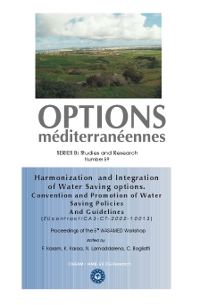| Article précédent | p. 175-182 |
Optimum crop design under limited and adequate irrigation possibilities in small scale farming enterprises of Gap-Tahilalan Irrigation Union
The GAP region enjoys a rather high agricultural potential in terms of its climatic and soil characteristics. Approximately 1.8 million hectares of land will be brought under irrigation in this region. In order to utilise the existing water and land resources of the region in most efficient way, studies on post-irrigation crop patterns and their respective shares are critical in the process of transition from rainfed to irrigated farming. The objective of the present study is to determine the crop design that will ensure maximum returns in a small-scale farm (30 decares) in the Tahilalan Irrigation Union in the Harran Plain under adequate and deficit irrigation conditions. In this context the study determines plant water needs for crops cultivable under given conditions, irrigation plans under adequate and deficit irrigation conditions, necessary inputs and costs gross profit margins. On the basis of this information, the optimum crop design is obtained by linear programming.
- [ Afficher ]
- [ Télécharger ]
- [ Exporter la citation ]
Vous pouvez télécharger la citation au format :
- [ Imprimer ]
-
Mots-clés
BESOIN EN EAU, EAU D'IRRIGATION, EFFICACITE D'UTILISATION, IRRIGATION, PENURIE, TURQUIE, UTILISATION DE L'EAUCiter cet article
Selli F., Benli B., Kodal S. Optimum crop design under limited and adequate irrigation possibilities in small scale farming enterprises of Gap-Tahilalan Irrigation Union. In : Karam F. (ed.), Karaa K. (ed.), Lamaddalena N. (ed.), Bogliotti C. (ed.). Harmonization and integration of water saving options. Convention and promotion of water saving policies and guidelines. Bari : CIHEAM / EU DG Research, 2007. p. 175-182. (Options Méditerranéennes : Série B. Etudes et Recherches; n. 59). 5. WASAMED (WAter SAving in MEDiterranean agriculture) Workshop, 2006/05/03-07, Malta (Malta). http://om.ciheam.org/om/pdf/b59/00800722.pdf



